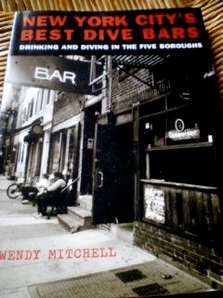Mark and Jimmy make another stop in Boulder at the oldest bar in the city limits, the Catacombs, in the basement of the 100 year old Boulderado Hotel.
Video #66: Solving O'Neill's! (Murder in Manasquan.)
Jimmy and Mark make a stop in Manasquan, NJ and investigate the only unsolved murder in the towns history with the aid of several pints of the best poured Guinness theyve ever seen. Also providing assistance are some great stories, incredible sushi, stars, funny and engaging people, music, games... and just a few blocks from the beach. Sound like heaven? Close... its ONeills.
Video #43: Ghost Hunting at the Jameson Tavern!
The Guys try their hand at ghost hunting at one of our favorite places in Maine, right in downtown Freeport. How a property can be so welcoming and creepy at the same time is beyond us; but make no mistake, it is very, very cool. If you are within a hundred miles of this place you must stop in and check it out. Great food, great local brews and spirits (pun somewhat intended) and enough stories to keep you coming back over and over again. Enjoy! Cheers!
Video #42: General Lafayette Inn.
The Guys continue their wanderings in the Philadelphia area, stopping off at this complete gem. Great history? Great Beer? Ghosts? We'll be right over.
Video #13: Mark has a look at the Jameson Tavern.
The Team makes their way back to Jameson's, one of the loveliest (and most haunted) bars in Maine.
THHG Book Club: Haunting and Diving.

We’ve all heard of eco-tourism by now: Vacation travel that visits places of natural beauty in a way that helps preserve the environment. Great idea, right? Well, the Happy Hour Guys have coined a new term in the same spirit: bev-tourism. Simply put, bev-tourism includes visiting pubs, taverns, saloons, breweries, wineries and distilleries of some significance. Surprisingly, these spots will often share parallel philosophies with eco-tourism destinations; many of the favorite beverage dispensaries we’ve visited practice business in an environmentally responsible way and contribute to the well-being of their communities. In addition, these properties are some of the most historic, quirky, creative, flat-out enjoyable places around, making it easy to be champions of bev-tourism. There are an increasing number of books being written about these places: Here are two more of our favorites.
First up, we have Wendy Mitchell’s 2003 guide, NEW YORK CITY’S BEST DIVE BARS “Drinking and Diving in the Five Boroughs”. Ms. Mitchell’s writing style is direct and to the point, like most of the bars she visits. We’re on the record as being avid dive bar fans, and Ms. Mitchell has been kind enough to do some leg work for those of you who feel the same. Alphabetically arranged with the criteria for a dive bar clearly laid out, Ms. Mitchell takes her readers on a crawl through the Big Apple’s most famous and infamous dives. She’d give Greg Louganis a run for his money. Best of all, she seems to really enjoy it. These are places she visits herself and her personal stories make each entry even richer. I’m not sureMcSorley’s Old Ale House should qualify as a “dive”, but quibbles like that aside, Ms. Mitchell has written a love letter to the smoky, seedy, sticky NYC that is disappearing under a crush of shiny condos and $12 pomegranate martinis. It’s a sad realization that since its publication in 2003, her list of dives has diminished significantly as developers continue their march through the city. Thus, a sad tip of the hat to Siberia, and many others no longer with us.
Next we move to Roxie J. Zwicker’s HAUNTED PUBS OF NEW ENGLAND: Raising Spirits of the Past. That’s right; pack the kids in the Previa because we’re going on a tour of the creepiest watering holes to serve grog since Our Founding Fathers. Zwicker does a nice job of painting the local picture for her readers, both currently and in an historical context. She hits her stride, though, when she shares the stories of the actual pubs and their ghostly inhabitants. It should be of little surprise that inns and taverns that saw the high drama of the creation of our country should be home to spirits who long to remain at the scene of their greatest moments of fame or infamy. These pubs have given rise to stories of both the famous and the obscure appearing to strangers. Privateers, patriots, rebels and spies as well as more commonplace murderers and victims can be encountered if the stories are to be believed. History, a good fright, and no shortage of adult beverages. Perfect for the whole family.
Both of these books are a great jumping off point, but neither can explore every possibility. There are dive bars around every corner in NYC and mysteries down many back roads throughout New England. Ideally, they will serve to pique your interest and let your curiosity lead you away. Both are available atwww.amazon.com .
What are you waiting for? Bev-Tour!
LEMP. A Haunting History.

“This Lemp’s for You.” If fate had played a kinder hand to the once dominant Lemp family brewing dynasty, we could indeed have been hearing that slogan instead of the famous version serenading us from our televisions today. Instead, the family suffered a tortuous series of tragedies, some of their own making, and has all but disappeared from most people’s memories. The story of their family and its rise and fall reminiscent of the most classic tragedies, is told by Stephen P. Walker in his incredibly researched book, Lemp: The Haunting History.
In 1840, German immigrant Adam Lemp opened his Western Brewery in St. Louis based on the popularity of the beer he had been brewing on a smaller scale in his grocery. In those days, brewers were much like neighborhood bakers, with local patrons picking beer up on their rounds of errands. Lemp’s decision to open a brewery was forward thinking, and took the operation to levels not commonly seen in those days. The brewery flourished, then more so once Lemp’s son, William, took control of the company. Under his leadership, the brewery grew with astounding speed, and he quickly moved to a larger facility to increase production. He chose a parcel of land directly above a series of caves his father had used to store beer. By the turn of the century, the now named William J. Lemp Brewing Co. covered 11 city blocks and produced 500,000 barrels of beer a year with distribution throughout all of North America and reaching Australia and Europe. The brewery produced six beers, the most known today being Falstaff. At this point the Lemp’s were larger and more influential than the Anheuser- Busch Brewery, who began business nearly two decades after they did.
Tragedy entered the family when Frederick Lemp, William’s heir apparent, died suddenly at age 28. Disconsolate, William fell into a deep depression and took his own life in 1904. The family soldiered on, but the tide had turned and time began to pass them by. Then the advent of Prohibition devastated the family business and they were forced to sell off assets at alarmingly low returns. William Lemp Jr., who had stepped into the leadership role after the deaths of his father and brother, became a high roller in St. Louis society and his divorce in 1920 provided scandalous gossip for the entire city. However, it was the disaster of Prohibition that defeated him. He, also, took his own life in 1922, as his sister Elsa had also done in 1920.
Despite the efforts of William Lemp III to re-introduce the brewery after Prohibition, the attempt failed. He died tragically in 1943 at age 42 of a cerebral hemorrhage. Another brother, Charles, also committed suicide in 1949. The famous label of Falstaff Beer was purchased and continued to be sold for a while under different owners until ultimately fading away.
All of this is told in detailed and fascinating accounts, often through written first-hand entries, by Walker. Letters of the Lemps themselves are quoted and newspaper articles of the time are reprinted. Walker also includes many examples of the famous Lemp advertising art and intricate descriptions of the lavish lifestyle and homes of the family. It’s a fascinating look at a chapter of American history, as well as brewing history, that is often overlooked.
Walker concludes with some accounts of ghostly goings on at the Lemp Mansion, which is now open as a bed and breakfast (www.lempmansion.com). Considering the history of the family, it’s almost to be expected that they would continue to haunt the scene of their greatest triumphs and failures. We’ll be visiting here with our cameras, no doubt.
A great read and highly recommended:
4 and a half pints out of 5!
Unfortunately, the book is out of print, but readily available atwww.beerbooks.com . A great resource for anyone interested in any aspect of the brewing industry.


